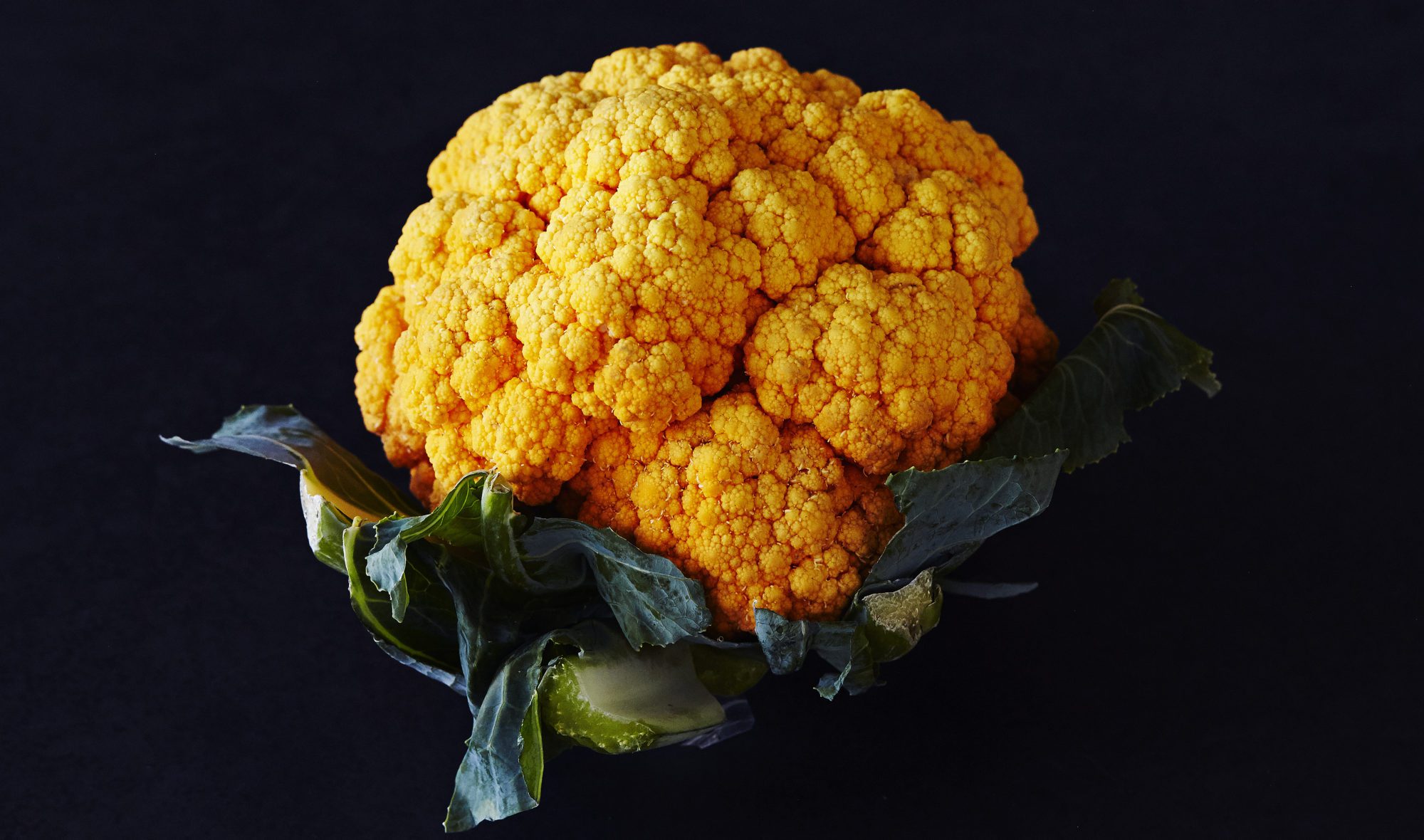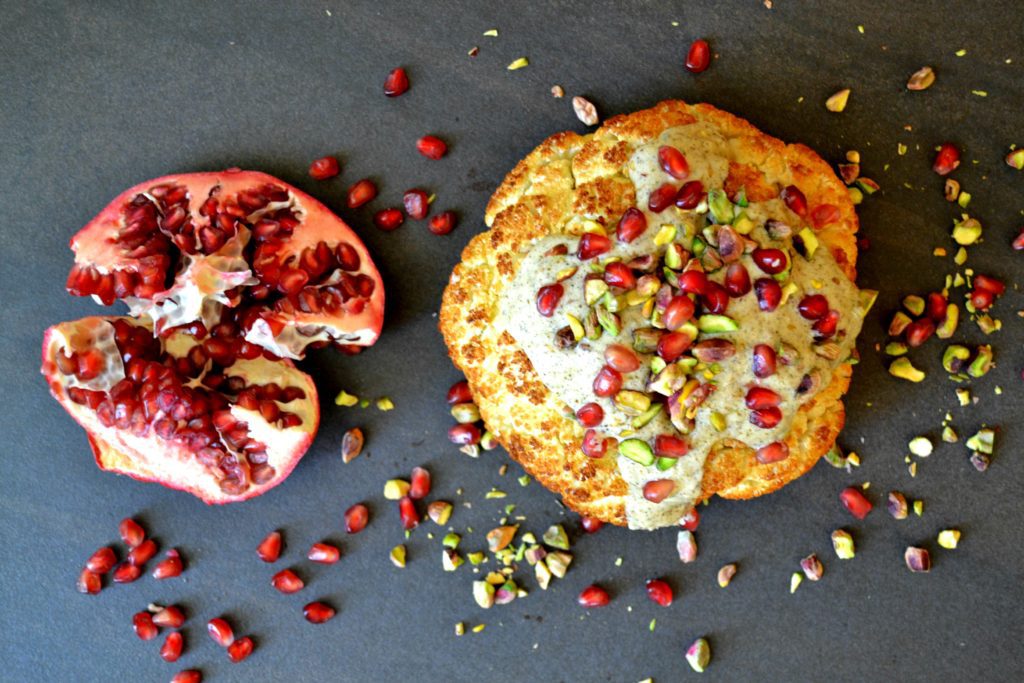
🎁 Holiday Special: SAVE 52% on the Nutrition Coach Starter Package. Limited number remaining.

🎁 Holiday Special: SAVE 52% on the Nutrition Coach Starter Package. Limited # left.

Cauliflower, which is part of the Brassica family, is most commonly a cream-colored, cloud-shaped vegetable. However, crossbred and heirloom varieties also exist in a range of vivid colors and geometrically inspiring shapes. Cauliflower is an excellent source of vitamin C in its raw form, and a good source of vitamin K. Although it is low in carbohydrates and fats, cooked cauliflower has a satisfying starchy and creamy taste.
Cauliflower is part of the Brassica family, which includes common veggies such as kale, cabbage, and broccoli.
Unlike many of its deeply green cousins, cauliflower is generally rather colorless. Its pale color relates to lack of sun exposure: Early in the growing process, farmers gather the large leaves that surround an immature cauliflower head and tie them together at the top of the head like a ponytail made of leaves. This ponytail creates a dark cavern for the cauliflower to grow without direct exposure to the sun. Without sun exposure, the cauliflower head, which is actually made up of many tiny clumps of flowers, remains white and the flower buds remain closed.
While the most common cauliflower is white, there are other varieties that, through crossbreeding (which is not the same as genetic modification) are bright orange or purple.
There is also the Romanesco cauliflower*, which is lime green, visually mesmerizing, and with its configuration of peaked florets within peaked florets, is a mathematical marvel, being a natural example of a fractal pattern.
China and India are the biggest global producers of cauliflower, but in North America, California is the cauliflower hub. For a period of time in late 2015, due to drought issues in California, the price of cauliflower became truly unreasonable. It was a dark time for cauliflower lovers.
*Note: Sometimes Romanesco cauliflower is called Romanesco broccoli or Romanesco cabbage.
The common white cauliflower looks like a very solid round cumulus cloud of clumped florets. These florets are made up of tiny clusters of flowers called curds. Crossbreeding has also produced versions of cauliflower that are neon orange or purple, due to increased amounts of beta carotene or anthocyanins, respectively. All varieties have a mild and slightly creamy flavor with a pleasing starchiness.
The Romanesco cauliflower is beautiful if not alien-like, with its mathematically precise arrangement of peaked green florets. Romanesco cauliflower is similar in flavor to regular cauliflower, with a mild hint of bitter green.
One cup of ½” cut raw cauliflower florets (about 107g) has 27 calories, 2.1g protein, 0.3g of fat, 5.3g of carbohydrates, 2.1g fiber, and 2g sugar. In its raw form, cauliflower is an excellent source of vitamin C, and a good source of vitamin K.
Cauliflowers are found widely in most grocery stores. They are typically sold as entire heads.
Look for cauliflowers that are heavy for their size with tightly packed curds. Cauliflowers that have dark spots or little budding florets are likely past their prime. If a cauliflower only has a few very small areas of dark spotting and otherwise looks fresh, you can just trim off the dark spots during your preparation to eat it.
As an entire head, raw cauliflower will stay fresh in the fridge for up to a week. To protect its moisture content, keep it in a paper or plastic bag.
If you have purchased raw pre-cut florets, consume them within a day or two.
After cooking, cauliflower can be kept in the fridge for two to three days. Any longer, and it will emit a sulfur smell.
After washing, trimming off any dark spots, and cutting into desired chunks, cauliflower is delicious in several ways.
Choose your own adventure:
Option 1: Eat it raw, just as is. Raw cauliflower is also a great vehicle for dip.
Option 2: Steam it. Place chopped florets in a steamer basket over boiling water and cook in a covered pot for about 5-10 minutes, the shorter time being for those who like to preserve a bit of crunch, and the longer time for those who like their cauliflower soft and smooth.
Option 3: Roast it. In a large bowl, drizzle cauliflower florets with a couple tablespoons of olive oil and a sprinkle of salt. Toss to coat florets. Spread seasoned florets over a parchment paper-lined baking tray and place in preheated 400 degree Fahrenheit oven. Roast for 25-30 minutes, removing the tray halfway through to rotate the florets for even browning. The cauliflower is done when it turns soft and golden brown at the edges.

This dish is visually impressive and equally delicious. A whole roasted cauliflower is garnished with flavors inspired by the Middle East: a creamy za’atar-infused tahini sauce, crunchy pistachios, and bright pops of pomegranate.
Prep Time: 10 minutes Cook Time: 75 minutes Yield: 6 servings
Cauliflower Directions:
Preheat the oven to 375 degrees Fahrenheit.
Pour olive oil over the cauliflower and massage so the whole head is coated. Sprinkle salt evenly over head. Next, place the cauliflower on a parchment paper lined baking tray. Bake for 75-90 minutes. Time will vary depending on the size of the cauliflower. Your cauliflower is done when it is brown on the edges and soft in the inside (you can stick a knife in it to assess).
Sauce Directions:
Add all ingredients to a jar and whisk with a fork until smooth and creamy.
When cauliflower is cooked, drizzle generously with tahini sauce and sprinkle with pistachios and pomegranate seeds. Alternatively, use the tahini sauce to dip chunks of cooked cauliflower into.
Enjoy!
Precision Nutrition’s Encyclopedia of Food expands every single month as we highlight new foods and showcase beautiful food photography. If you’d like to stay up to date, simply click this link. From there, we’ll send you a FREE copy of our recipe book. We’ll also let you know when new and delicious foods are added to the site.
Cauliflower, which is part of the Brassica family, is most commonly a cream-colored, cloud-shaped vegetable. However, crossbred and heirloom varieties also exist in a range of vivid colors and geometrically inspiring shapes. Cauliflower is an excellent source of vitamin C in its raw form, and a good source of vitamin K. Although it is low in carbohydrates and fats, cooked cauliflower has a satisfying starchy and creamy taste.